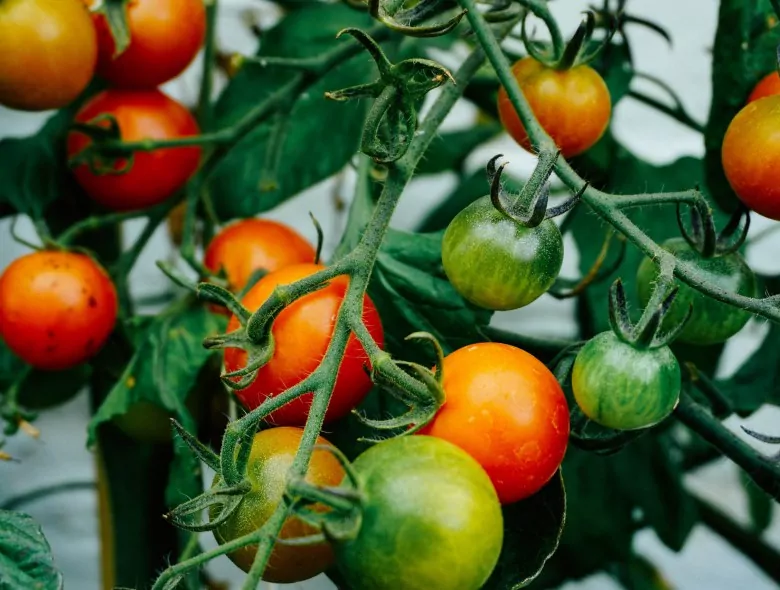Many apartments in Japan have small balconies which most people use for drying laundry. There are different ways to utilize this space however and adding Japanese plants to create a balcony garden will liven up your apartment. You can utilize this space to make a veranda vegetable garden and grow as much fresh produce as your space allows. Though a balcony garden can be a bit of an investment and will certainly require a bit more effort than just buying the produce at the supermarket, we recommend trying to grow food since it can be a wholesome and rewarding process.

Growing a tomato plant
The tomato plant is a popular first choice if you’re considering dabbling in a veranda vegetable garden, especially if you’re low on space. The fruit from a tomato plant grows quickly and it will fill your balcony garden with color and the aroma of fresh tomatoes. Tomatoes are a delicious organic food to grow, you’ll notice the difference in the flavor of homegrown tomatoes compared to the regular store-bought ones. Once you’ve grown your first tomatoes, you’ll never want to go back to the supermarket ones!
Gardening centers sell wide and long containers around 25cm deep that work well for a tomato plant. They grow tall vertically so need to be planted deep so that the tomato plant can get strong. At the gardening center, you can find seeds or seedlings with guidance on how to grow tomatoes.
For your first time – or if you are a bit late in the season – try the seedlings (the young plants) and transplant them into the big containers when you get home. You’ll also need to purchase a bag of soil, there are soil mixes specifically for tomatoes at most gardening shops and we recommend mixing in some slow-release fertilizer. Add a layer of gravel at the bottom of your pot to help the drainage so that your tomato plant doesn’t rot.

Growing mushrooms
Whilst not necessarily a plant, mushrooms can be fun to grow and don’t require the same sunlight as the other organic food on this list, so they are great for growing indoors and in winter. Oyster mushrooms and Shiitake mushrooms are popular types of mushrooms to grow.
Mushrooms grow from spores, not seeds, and are nourished by sawdust, wood chips, and straw, rather than soil. Since you’ll need to buy spores and a growing medium, they can be difficult to grow but there are plenty of mushroom cultivating kits available now which come with everything you need and make the experience of growing mushrooms very easy. We recommend the kits for anyone; the mushroom kits might just change your mind if you’re convinced that you don’t have a green thumb.
Mushrooms need to be in a dark spot to grow best and though they can grow in all seasons, winter might be best since it is cooler. They like a humid environment. Follow the instructions on your mushroom growing kit, you’ll usually have to soak the growing medium once at the start and then spray the kit with some water every day, within a few weeks your mushrooms should be ready for harvesting.

Growing a herb garden
Fresh herbs can be expensive in Japan and you can normally only buy them in small amounts from the supermarket so growing a herb garden is not only a great way to get delicious and organic food, but it’s also a great way to save money.
Growing a herb garden indoors is possible if you have a sunny window so this is an option that would suit anyone without space for a balcony garden. The best herbs to grow indoors are basil, mint, parsley, oregano, rosemary, thyme, and chives. Most herbs thrive in with a lot of sunlight, so they’ll also do well on a balcony in the veranda vegetable garden. If you don’t have any spots with bright sunlight, or if you’d like to grow herbs in winter, consider investing in a small grow light to help the herbs photosynthesize.
At garden centers, you’ll find seeds or small herb plants you can then put into bigger pots. Make sure the pots for your herb garden have drainage and a drip tray to catch any leaking water.
Try incorporating some Japanese plants such as Shiso into your herb garden.

Growing berries
Berries such as raspberries and strawberries can grow well as part of your balcony garden. They’ll need access to bright sunlight, so if your balcony is in the shade most of the time growing berries might not be possible for you.
Strawberries grow well in hanging baskets and are a popular choice to grow in small spaces. Raspberries grow vertically, so much like tomatoes, they will benefit from having support in place – make sure to plant the support when you re-pot a raspberry plant. It can damage the roots if you stick the support poles into the soil after the plant is already established.

Growing Aloe Vera
It’s always worth having some aloe vera growing inside your apartment since it has so many healing qualities; you can harvest aloe vera to use on your skin as a moisturizer or to relieve sunburn. Though the main uses of aloe vera are not strictly for food, you can use the gel inside to make aloe vera juice if you have a blender.
Aloe vera plants are easy to care for and aloe vera plants are usually quite cheap to purchase. They like bright light but don’t need watering very often so let most of the soil dry out before watering.
Try out some Japanese plants in your veranda vegetable garden too, if you have a large enough space you can try growing Japanese cucumbers and aubergines!



